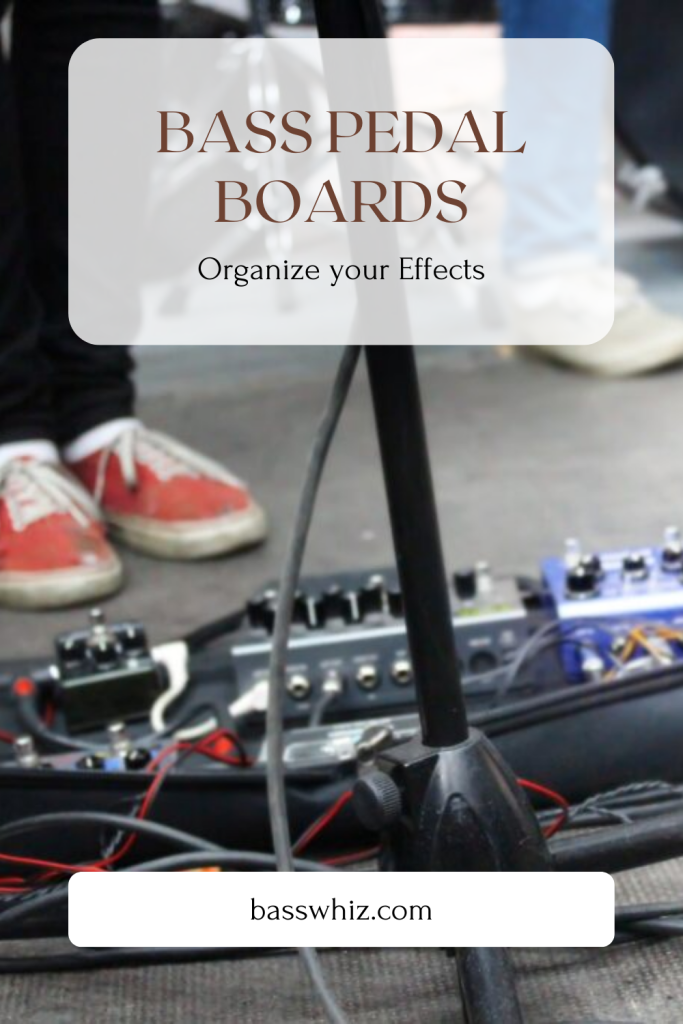Bass Pedal Boards: Organize your Effects
Unlocking the Potential of Your Bass Rig with Bass Pedal Boards
You must recognize the importance of having a well-organized and optimized setup. One crucial component that often goes overlooked is the bass pedal board. These versatile platforms are essential for housing and arranging your pedals, providing convenience, efficiency, and unleashing your creativity. In this article, I will guide you through the world of bass pedal boards, helping you choose the right one and offering valuable tips to enhance your performance.
What are bass pedal boards?
Bass pedal boards are specially designed platforms that hold and organize your bass effects pedals. They provide a centralized location for your pedals, allowing easy access during performances or practice sessions. By keeping your pedals organized and securely mounted, pedal boards offer a streamlined setup and minimize the chances of cables tangling or pedals getting accidentally dislodged.
Importance of bass pedal boards
Investing in a quality bass pedal board is a game-changer for bass players. Not only do they keep your effects pedals organized, but they also offer several benefits that significantly impact your playing experience. A well-designed pedal board ensures:
Quick and hassle-free setup:
With all your pedals securely attached to the board, you can spend less time connecting and arranging them, and more time playing your bass.
Easy transportation:
Bass pedal boards are designed to be portable, allowing you to conveniently carry your effects pedals to gigs, rehearsals, or studio sessions.
Protection for your pedals:
Pedal boards offer a sturdy and safe platform for your pedals, protecting them from damage caused by accidental drops or spills.
Enhanced creativity:
By having your pedals neatly organized, you can experiment with different effects combinations and create unique sounds, unleashing your creativity and expanding your sonic possibilities.
Types of Bass Pedal Boards
When it comes to bass pedal boards, there are various types to choose from, each catering to different needs and preferences.
Powered vs. non-powered
One of the first decisions to make is whether you need a powered or non-powered pedal board. Powered pedal boards come with a built-in power supply, eliminating the need for individual power adapters for each pedal. They simplify the setup process and ensure a consistent
and clean power source for all your pedals. On the other hand, non-powered pedal boards require separate power adapters for each pedal, offering more flexibility but requiring additional cable management.

Traditional vs. modular
Traditional pedal boards feature a fixed layout with pre-drilled holes or slots to mount your pedals. They offer a straightforward and reliable setup, ideal for those with a fixed pedal configuration. Modular pedal boards, on the other hand, provide a customizable layout with interchangeable plates or rails. This versatility allows you to rearrange and swap pedals easily, accommodating changes in your effects chain or adding new pedals to your setup.
Pedalboard size options
Pedal boards come in various sizes, and choosing the right one depends on the number and size of your pedals. Small pedal boards are compact and lightweight, suitable for players with a minimal pedal collection or those looking for maximum portability. Medium-sized pedal boards offer a balance between portability and pedal capacity, accommodating a moderate number of pedals. Large pedal boards are designed for extensive pedal collections, giving you ample space for multiple effects pedals, loopers, or even additional accessories like expression pedals.
Choosing the Right Pedal Board
Selecting the perfect pedal board for your needs requires careful consideration of several factors.
Assessing your needs
Start by evaluating your playing style, gigging frequency, and the number of pedals you currently use or plan to acquire. Understanding your specific requirements will help you determine the size, type, and features you should look for in a pedal board.
Considering pedal quantity
Take into account the number of pedals you need to accommodate both now and in the future. It’s always a good idea to choose a slightly larger pedal board than your current needs to allow room for expansion. This ensures that you won’t outgrow your board as your pedal collection grows.
Portability and durability
If you frequently travel or gig, portability becomes a crucial factor. Look for pedal boards that are lightweight, compact, and easy to carry. Additionally, prioritize durability to withstand the rigors of transportation and heavy usage. Opt for sturdy materials like aluminum or reinforced plastic that can withstand impacts and provide long-lasting performance.
Setting Up Bass Pedal Boards
Once you have chosen the right pedal board, it’s time to set it up for optimal performance.
Organizing pedals
Consider the order and arrangement of your pedals on the board. The signal chain plays a significant role in achieving the desired tone and avoiding unwanted interference. Typically, it is recommended to place filters, compressors, and EQ pedals at the beginning of the chain, followed by modulation effects like chorus and phasers, and ending with time-based effects such as delays and reverbs.
Cable management
To maintain a tidy and organized pedal board, pay attention to cable management. Use high-quality patch cables of appropriate length to connect your pedals efficiently, minimizing excess cable length that can cause tangling or signal loss. Additionally, consider using cable ties, zip ties, or Velcro straps to secure and route the cables neatly along the board.
Power supply options
Ensure that your pedal board has a suitable power supply solution. Powered pedal boards typically come with built-in power sources, eliminating the need for individual power adapters. If you opt for a non-powered board, explore options like isolated power supplies or daisy chain adapters to provide clean and reliable power to your pedals, reducing noise and hum.
Tips for Optimal Performance
To further enhance your bass pedal board experience, here are some additional tips to consider:
Signal chain considerations
Experiment with different signal chain configurations to find the best order for your pedals. Don’t be afraid to swap positions or try unconventional arrangements to discover unique sounds and textures. Remember that the signal chain can significantly impact the overall tone and interaction between your effects pedals.
Proper pedal placement
Pay attention to the physical placement of your pedals on the board. Consider the accessibility and ease of foot operation for each pedal. Ensure that pedals with footswitches or knobs you frequently adjust are easily reachable and comfortable to use during performances. This arrangement allows for seamless transitions between effects and reduces the chance of accidentally engaging or disengaging pedals.
Troubleshooting common issues
Sometimes, despite careful setup, you may encounter issues like noise, hum, or signal loss. In such cases, troubleshooting can help identify and resolve the problem. Check for loose cables, faulty connections, or damaged pedals. Consider using high-quality cables and connectors, as well as noise reduction pedals or filters to address any unwanted noise or interference.
Must-Have Bass Pedal Board Accessories
To complete your bass pedal board setup, certain accessories can enhance its functionality and organization.
Patch cables
Invest in reliable and high-quality patch cables to connect your pedals. These short-length cables minimize signal loss and interference while keeping your board tidy and free from excess cable clutter.
Velcro and adhesive
Use Velcro or adhesive strips to securely attach your pedals to the board. This ensures they stay in place during transportation or vigorous performances, preventing accidental pedal movement or dislodgment.
Cable ties and zip ties
Employ cable ties or zip ties to manage and bundle your cables effectively. This keeps them organized and prevents tangling, making it easier to troubleshoot or reconfigure your board if needed.
Conclusion
A well-designed and properly organized bass pedal board is a valuable asset for any bass player. It not only provides convenience and efficiency but also unlocks new creative possibilities. By carefully choosing the right pedal board, setting it up thoughtfully, and optimizing your signal chain, you can enhance your bass playing experience and achieve a wide range of captivating tones and effects.
FAQs
- What size pedal board do I need?
The size of your pedal board depends on the number and size of your pedals. Assess your current pedal collection and consider future expansion to choose a board that provides ample space while remaining portable. - How do I prevent cable tangling on my pedal board?
Use appropriate cable management techniques such as Velcro straps, cable ties, or zip ties to secure and route your cables neatly along the board, minimizing tangling and ensuring a tidy setup. - Can I use a guitar pedal board for bass?
While guitar pedal boards can be used for bass, it’s recommended to choose a pedal board specifically designed for bass. Bass pedal boards often have additional features to accommodate the lower frequencies and heavier-duty construction to withstand the demands of bass playing. - What’s the best way to power my pedal board?
The best power supply option depends on your specific needs. Powered pedal boards offer convenience with built-in power sources, while non-powered boards allow flexibility but require individual power adapters or dedicated power supplies. Consider factors like noise reduction, isolation, and sufficient power outputs when selecting a power solution. - How can I optimize my signal chain for bass effects?
Experiment with different signal chain configurations to find the best order for your pedals. Start with filters, compressors, and EQ pedals at the beginning, followed by modulation effects, and end with time-based effects. Don’t be afraid to try new arrangements to achieve unique and desired tones.




